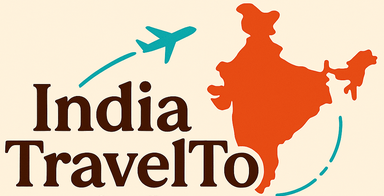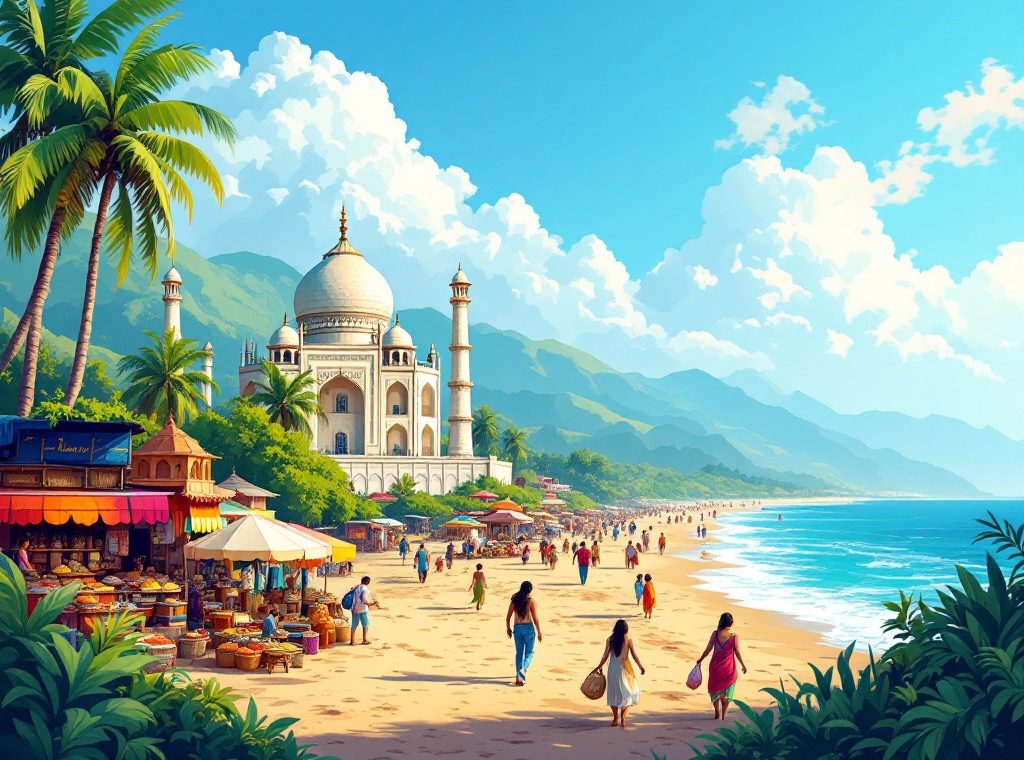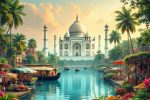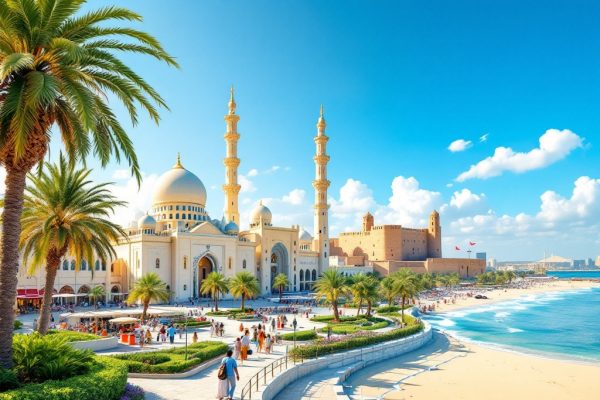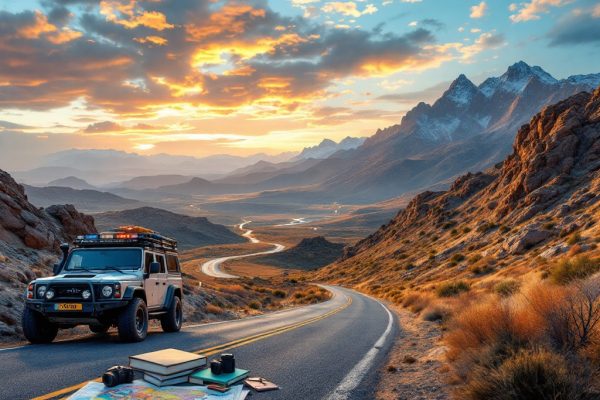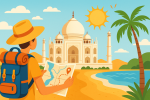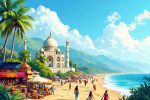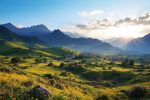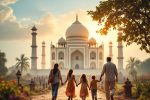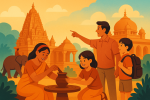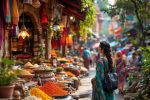The Best Time to Travel to India: A Month-by-Month Guide
Dream of exploring India’s vibrant culture and stunning landscapes? Discover the magic of India’s winter, from October to March, with warm days perfect for exploring ancient sites and bustling markets. From the Himalayas to the beaches of Goa, learn the ideal time to visit each region for an unforgettable experience. Uncover insider tips for navigating festivals, weather, and accommodations. Start planning your dream Indian adventure today!
Important information
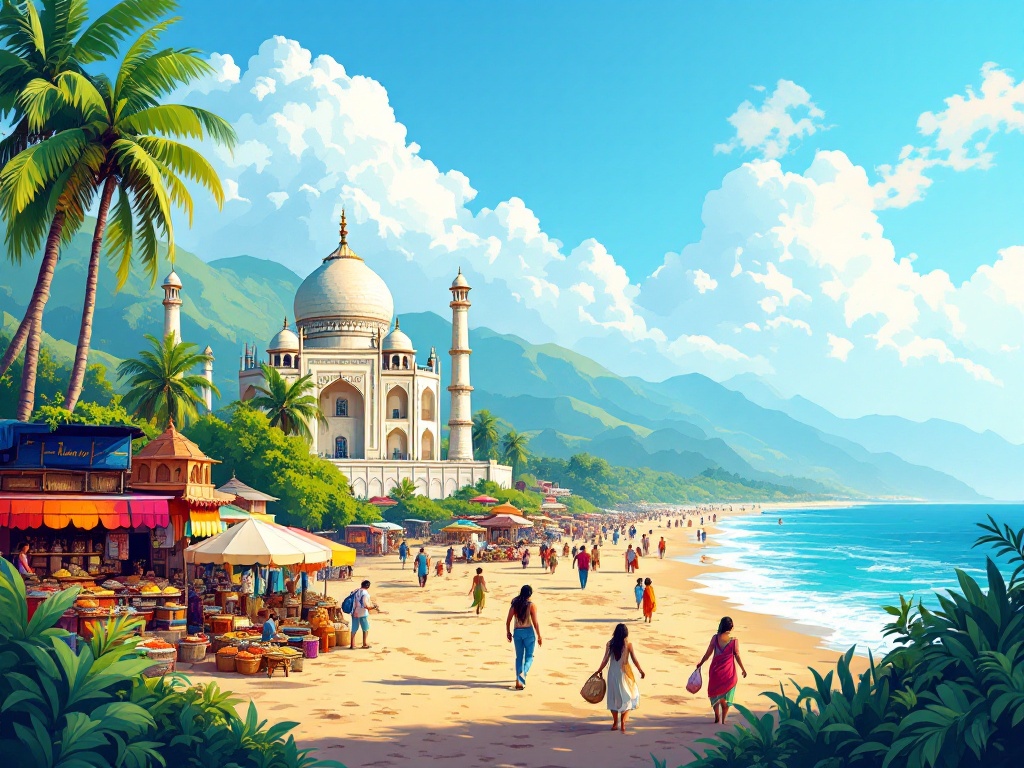
- October to March is the peak tourist season, offering pleasant weather ideal for exploring most regions.
- The monsoon season (July-August) offers a unique experience with fewer crowds and lush landscapes, best for budget travelers and those interested in Ayurvedic treatments.
- Wildlife viewing is optimal in March and April, especially in central India, as animals gather near water sources.
- The Himalayas are best for trekking in May-June (pre-monsoon) or September-October (post-monsoon).
- Book accommodations and transport in advance, especially for festivals like Diwali (Oct/Nov) and Holi (Mar), and during peak season.
The Best Time to Travel to India: An Overview
Experience India’s winter magic from October to March, with warm, sunny days perfect for exploring ancient sites, bustling markets, and vibrant landscapes. This pleasant weather is ideal for sightseeing, outdoor adventures, and cultural immersion. However, India’s diverse climate offers regional variations. Summer is the best time to visit the Himalayas. Research your specific region’s climate for accurate weather information when planning your trip.
Why October to March is Ideal
India truly sparkles from October to March, offering mild and pleasant weather. Across North India, expect brilliant blue skies, while the Northeast unveils its magic during this prime exploring season. Beach lovers will also find this period perfect for coastal adventures. Consider these ideal months for your unforgettable Indian getaway.
Weather Insights for Travelers
India experiences cooler temperatures in December and January, particularly in the north, often accompanied by fog. However, March offers ideal conditions for wildlife enthusiasts. Pleasant weather in March is perfect for exploring India’s parks and enjoying various outdoor activities and sightseeing.
Month-by-Month Guide to Traveling in India
January: Cool, pleasant weather, especially in the north, making it perfect for exploring Rajasthan, enjoying Goa’s beaches, or cruising Kerala’s backwaters.
February: Pleasant weather continues, ideal for outdoor activities, historical site visits, and cultural festivals like Gujarat’s Kite Festival.
March: Warmer weather arrives, perfect for wildlife viewing and celebrating the vibrant Holi festival of colors.
April: Remains excellent for wildlife spotting as temperatures climb, particularly in central and southern India.
May: Pre-monsoon humidity makes it an opportune time for Himalayan treks before the rains arrive.
June: Rain transforms the landscapes into lush green paradises.
July & August: Peak monsoon season offers a unique, less crowded experience of India’s natural beauty.
September: The monsoon ends and clear skies return, marking a tranquil transition period.
October: Tourist season begins with clear skies and pleasant temperatures.
November: Agreeable weather and numerous festivals, including Diwali, make it a popular time to visit.
December: Cooler temperatures return, especially in the north, along with a festive atmosphere with Christmas celebrations.
January: Cool Weather and Beach Vacations
Experience India in January: A diverse range of destinations awaits. For cool weather exploration, Northern India offers ideal sightseeing temperatures, ranging from 41°F (5°C) to 68°F (20°C). Seeking warmer temperatures? Southern regions like Kerala boast balmy weather between 59°F (15°C) and 86°F (30°C). Beach lovers can bask on Goa’s irresistible shores. Meanwhile, Rajasthan presents a unique blend of warm days and cool nights, perfect for exploring ancient forts and monuments. For breathtaking mountain vistas, the Himalayas beckon, but remember to pack for colder conditions.
February: Pleasant Weather and Cultural Festivals
February is a delightful time to explore India, with pleasant weather ideal for sightseeing. Temperatures typically range from 10°C to 30°C (50°F to 86°F), while southern regions like Tamil Nadu and Kerala are warmer, averaging 20°C to 32°C (68°F to 90°F). Cities like Delhi and Jaipur offer comfortable days to discover ancient forts and vibrant markets. February is also a month of cultural richness, exemplified by Gujarat’s spectacular Kite Festival. Wildlife enthusiasts will find India’s national parks teeming with animals, making it a prime time for viewing. Remember to book accommodations in advance as hotels fill up quickly.
March: Ideal for Wildlife Viewing and Holi Celebrations
Experience India in March with ideal exploration weather. Temperatures range from a pleasant 15°C to 30°C (59°F to 86°F). This comfortable climate makes wildlife viewing exceptional, particularly in central India, where animals gather near water sources. March also features the vibrant Holi festival, a unique cultural experience celebrating the triumph of good over evil with colorful powders.
April: Wildlife Spotting and Rising Temperatures
India’s wildlife flourishes in April, making it an ideal time for observation. Central India’s national parks, such as Kanha, Bandhavgarh, and Pench, are particularly recommended. As temperatures rise, animals gather around water sources, increasing your chances of sightings. Expect daytime temperatures between 25°C and 35°C (77°F and 95°F). While the Easter holiday may lead to higher accommodation costs, booking in advance is recommended to secure your spot. For a more comfortable experience, consider early morning or evening excursions to avoid the midday heat.
May: Pre-Monsoon Adventures and Trekking in Himalayas
Planning an Indian adventure in May? The Himalayas are ideal for trekking between May and June or September and October. However, May’s intense heat and humidity, sometimes peaking at 113°F, can make Himalayan treks strenuous. For a more comfortable May escape, consider India’s cooler hill stations and coastal regions. These destinations offer a refreshing break from the heat.
June: Beginning of Monsoon and Lush Scenery
India’s monsoon season begins in June, dramatically changing the landscape. While the northern plains see pre-monsoon showers and high temperatures, the south and coastal areas, such as Kerala, receive much more rain. For travelers seeking cooler temperatures, the hill stations offer a refreshing retreat amidst lush greenery. Ladakh, on the other hand, experiences sunny weather, perfect for trekking.
July and August: Monsoon Season and Fewer Tourists
Discover a unique side of India during the monsoon season (July and August). With fewer tourists, you’ll experience a more peaceful atmosphere and witness the country’s vibrant transformation into a lush, green paradise. While rain is frequent, it’s an ideal time to explore hill stations, especially in the Western Ghats, known for serene landscapes and smaller crowds. A Ganges River cruise is also highly recommended, as the elevated water levels create a truly special journey. Be sure to book ahead due to its popularity and be prepared for possible travel delays in areas affected by the rain.
September: End of Monsoon and Transition Period
As India’s monsoon season fades in September, temperatures cool and tourist crowds thin, creating ideal travel conditions. Kerala’s backwaters offer tranquil beauty. The northern hills provide a refreshing retreat.
September is also a month of vibrant festivals. Witness the energy of Ganesh Chaturthi and the cultural richness of Rajasthan’s Marwar Festival.
However, some lingering rain may impact travel in the south. Ladakh’s travel season concludes this month.
In Rajasthan, the weather is improving, though still variable.
Best Time to Visit India by Region
Escape to Northern India this winter, from October to March, for clear skies and radiant sunshine.
Southern India’s dry season, spanning November to May, is perfect for exploring ancient temples and sun-kissed beaches.
West India, including Goa, welcomes visitors from October to March with dry, pleasant weather ideal for beach relaxation and exhilarating water sports.
Central India’s wildlife parks offer prime animal viewing from October to June, with excellent visibility.
For a taste of culture and sightseeing, Eastern India is most agreeable from October to March, boasting moderate temperatures.
If Himalayan trekking is your passion, target the pre-monsoon season (April-May) or post-monsoon (September-October) for optimal conditions and breathtaking scenery.
Northern India: When Clear Skies Dominate
Experience Northern India’s vibrant beauty under stunning blue skies from October through March. This is the ideal time to plan your trip, ensuring perfect weather conditions for your exploration.
Southern States: Enjoy the Dry Season
Southern India’s dry season begins in November, offering pleasant weather ideal for travel. Popular destinations such as the southern states of Kerala and Goa are especially appealing during this time.
West India: Ideal Months for Beach Activities
Planning a beach getaway to West India? The ideal time to visit is between November and March, when you can expect sunshine and comfortable temperatures, perfect for enjoying the coast. However, from April to October, the climate shifts to hot and humid conditions, coinciding with the monsoon season. Therefore, for optimal beach weather, stick to the winter months.
Central India: Explore Wildlife Parks
For optimal wildlife viewing in Central India, plan your safari during March and April. The summer heat draws animals to water sources, creating prime viewing opportunities. Visiting during these months maximizes your chances of unforgettable wildlife encounters.
